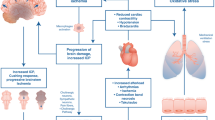Abstract
The body as a whole, along with individual organs and tissues, is the source for many examinations and measures relating to both teaching and research in medicine. There is no possibility of having an alternative model for the body in the near future. When it comes to organ and tissue donation activities, the human body gives other people another chance in life and indicates a better quality of life for many. Therefore, interventions on the deceased are carried out at the Institute of Legal Medicine in Hamburg (with the declaration of consent being taken from the person during lifetime or the relatives) for teaching, research, and clinical practices other than judicial autopsies. This includes scientific investigations in clinical research projects and surgical interventions within the framework of the Post-mortem Learning Centre and tissue donation, especially cornea transplantation in Germany and abroad. For clinical research projects, especially regarding quality assurance and innovation, post-mortem procedures on corpses are increasingly becoming the focus of attention.
Zusammenfassung
Der Körper im Ganzen sowie einzelne Organe und Gewebe sind Grundlage vielerlei Untersuchungen und Maßnahmen in Lehre und Forschung der Medizin, für die es in naher Zukunft keinen alternativen Ersatz und keine geeigneten Modelle geben wird. Der menschliche Körper stellt im Zusammenhang mit Organ- und Gewebespende eine Lebenschance und die Quelle eines großen Zugewinns an Lebensqualität dar. Deshalb werden am Institut für Rechtmedizin in Hamburg neben gerichtlichen Sektionen weitere Eingriffe an Verstorbenen im Rahmen von Lehre, Forschung und klinischer Praxis, nach Einverständniserklärung zu Lebzeiten oder durch Angehörige, durchgeführt. Dazu gehören wissenschaftliche Untersuchungen in klinischen Forschungsprojekten, chirurgische Eingriffe im Rahmen des sog. Post Mortem Learning Centers und Gewebespenden, insbesondere der Cornea im In- und Ausland. Bei klinischen Forschungsvorhaben, speziell in Hinblick auf Qualitätssicherung und Innovation, rücken die postmortalen Prozeduren die Rechtsmedizin immer mehr ins Zentrum der Aufmerksamkeit.


Similar content being viewed by others
References
Madea B (2004) 100 Jahre Deutsche Gesellschaft für Gerichtliche Medizin/Rechtsmedizin vom Gründungsbeschluss 1904 zur Rechtsmedizin des 21. Jahrhunderts
Mallach HJ (1996) Geschichte der gerichtlichen Medizin im deutschsprachigen Raum. Schmidt-Römhild, Lübeck
Püschel K (2016) Lehre und Forschung an Verstorbenen. Rechtsmedizin 26:115–119. https://doi.org/10.1007/s00194-016-0087-0
Püschel K, Wulff B (2012) Die Gewebespende in der Rechtsmedizin am Beispiel Hamburg. In: Wienke A, Rothschild MA, Janke K (eds) Rechtsfragen der Obduktion und postmortalen Gewebespende. Springer, Berlin, Heidelberg, pp 89–96
Puschel K, Bratzke H, Graw M, Wulff B (2010) Positionspapier der Deutschen Gesellschaft für Rechtsmedizin zur Förderung der postmortalen Gewebespende. Rechtsmedizin 20:61–62
Alix-Panabieres C, Pantel K (2016) Clinical applications of circulating tumor cells and circulating tumor DNA as liquid biopsy. Cancer Discov 6(5):479–491. https://doi.org/10.1158/2159-8290.Cd-15-1483
Diaz LA Jr, Bardelli A (2014) Liquid biopsies: genotyping circulating tumor DNA. J Clin Oncol 32(6):579–586. https://doi.org/10.1200/jco.2012.45.2011
Braun S, Vogl FD, Naume B, Janni W, Osborne MP, Coombes RC, Schlimok G, Diel IJ, Gerber B, Gebauer G, Pierga JY, Marth C, Oruzio D, Wiedswang G, Solomayer EF, Kundt G, Strobl G, Fehm T, Wong GY, Bliss J, Vincent-Salomon J, Pantel K (2005) A pooled analysis of bone marrow micrometastasis in breast cancer. N Engl J Med 353(8):793–802
Genovese G et al (2014) Clonal hematopoiesis and blood-cancer risk inferred from blood DNA sequence. N Engl J Med 371(26):2477–2487. https://doi.org/10.1056/NEJMoa1409405
Buschmann C, Kleber C, Tsokos M et al (2016) Mortui vivos docent. Anaesthesist 65:601–608. https://doi.org/10.1007/s00101-016-0194-z
Hess M et al (2013) Picosecond infrared laser (PIRL): an ideal phonomicrosurgical laser? Eur Arch Otorhinolaryngol 270(11):2927–2937. https://doi.org/10.1007/s00405-013-2561-6
Schardey HM et al (2008) Invisible scar endoscopic thyroidectomy by the dorsal approach: experimental development of a new technique with human cadavers and preliminary clinical results. Surg Endosc 22(4):813–820. https://doi.org/10.1007/s00464-008-9761-y
Hahn M, Moritz M, Friesecke C, Amling M, Püschel K (2013) Osteointegration humaner Allografts. In: Wulff B, Püschel K, Braun C, de By T, Hetzer R (eds) Tissue donor recruitment and long-term outcome following tissue transplantation. Forschungsergebnisse aus dem Institut für Rechtsmedizin der Universität Hamburg, 1st edn. vol 25. Verlag Dr. Kovač, Hamburg, pp 69–72
Aboutara M, Püschel K, Wulff B (2015) Communication skills of doctors in German forensic medicine institutes. Rechtsmedizin 25(2):139–144. https://doi.org/10.1007/s00194-015-0013-x
Busse B et al (2010) Decrease in the osteocyte lacunar density accompanied by hypermineralized lacunar occlusion reveals failure and delay of remodeling in aged human bone. Aging Cell 9(6):1065–1075. https://doi.org/10.1111/j.1474-9726.2010.00633.x
Meyer T et al (2012) Virus NAT for HIV, HBV, and HCV in post-mortal blood specimens over 48 h after death of infected patients—first results. Transfus Med Hemother 39(6):376–380. https://doi.org/10.1159/000345610
Wulff B, Heinemann A, Meins S, Puschel K, Müller K (2013) A retrospective evaluation of informed consent for tissue donation within a year of the donor’s death. Forensic Sci Int 231(1–3):240–243. https://doi.org/10.1016/j.forsciint.2013.05.005
Henners D (2018) Post Mortem Learning: Bedarfsanalyse und wissenschaftlicher Mehrwert medizinischer Lehr-Lern-Projekte an Verstorbenen
Wulff B, Graw M, Püschel K, Heinemann A, Braun C (2014) Postmortale Gewebespende in der Rechtsmedizin. Rechtsmedizin 24(3):221–231. https://doi.org/10.1007/s00194-014-0956-3
Casagrande M (2019) The creation of a cornea bank and corneal transplantation in Rwanda. Rwanda Public Health Bull 1(2):31
Ejzenberg D et al (2018) Livebirth after uterus transplantation from a deceased donor in a recipient with uterine infertility. Lancet 392(10165):2697–2704
Author information
Authors and Affiliations
Corresponding author
Ethics declarations
Conflict of interest
K. Püschel, A. Heinemann, E. Dietz, O. Hellwinkel, D. Henners and A. Fitzek declare that they have no competing interests.
For this article no studies with human participants or animals were performed by any of the authors. All studies performed were in accordance with the ethical standards indicated in each case.
Rights and permissions
About this article
Cite this article
Püschel, K., Heinemann, A., Dietz, E. et al. New developments and possibilities in the field of post-mortem medicine mortui vivos docent . Rechtsmedizin 30, 425–429 (2020). https://doi.org/10.1007/s00194-020-00402-3
Published:
Issue Date:
DOI: https://doi.org/10.1007/s00194-020-00402-3




